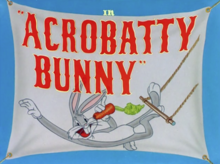Acrobatty Bunny
| Acrobatty Bunny | |
|---|---|
 | |
| Directed by | Robert McKimson |
| Story by | Warren Foster |
| Produced by | Edward Selzer |
| Starring | Mel Blanc |
| Music by | Carl W. Stalling |
| Animation by | Richard Bickenbach Art Davis Cal Dalton Don Williams Anatolle Kirsanoff |
| Layouts by | Cornett Wood |
| Backgrounds by | Richard H. Thomas |
| Color process | Technicolor |
Production company | |
| Distributed by | Warner Bros. Pictures |
Release date | June 29, 1946 |
Running time | 7:43 |
| Language | English |
Acrobatty Bunny is a 1946 Warner Bros. Looney Tunes short directed by Robert McKimson.[1] The short was released on June 29, 1946, and stars Bugs Bunny and Nero the Lion.[2]
Plot synopsis

A circus is being set up just above Bugs' rabbit hole, causing much noise and vibration. The lion cage is set up directly above the hole, and the lion takes deep sniffs (alternatively yanking Bugs towards the hole or throwing him back) to determine that the animal below is Bugs. When the lion (whom Bugs eventually refers to as "Nero") roars again, Bugs comes to the surface to see what's going on, riding an elevator that makes twists and turns. Bugs tries to reason with the lion, but soon makes a hasty escape when Nero takes a swipe at him.
Nero manages to get out of his cage, and chases Bugs around the circus grounds. Bugs at one point ducks into a dressing room, coming out as a clown trying to convince Nero to laugh, which he eventually does — until Bugs takes some whacks at the lion with a wooden board. The lion then chases Bugs into the big top, where they swing around acrobat swings. Eventually, Bugs tricks Nero into a cannon and sets the cannon off, causing Nero to do a hula in his 'skirt', plays the ukulele.
Crew
- Animation: Arthur Davis, Cal Dalton, Richard Bickenbach, Don Williams, Anatole Kirsanoff
- Inbetween: Lloyd Turner
- Character Design: Jean Blanchard
- Story: Warren Foster
- Layouts and Backgrounds: Cornett Wood, Richard H. Thomas
- Film Editor: Treg Brown
- Voice Characterizations: Mel Blanc
- Musical Direction: Carl W. Stalling
- Orchestrations: Milt Franklyn
- Production: Edward Selzer
- Direction: Robert McKimson
Availability
The cartoon can be found on the Looney Tunes Golden Collection: Volume 3 DVD. It is also available on the Marx Brothers' Night in Casablanca DVD (2004).
References
- ^ Lenburg, Jeff (1999). The Encyclopedia of Animated Cartoons. Checkmark Books. p. 60. ISBN 0-8160-3831-7. Retrieved 6 June 2020.
- ^ Beck, Jerry; Friedwald, Will (1989). Looney Tunes and Merrie Melodies: A Complete Illustrated Guide to the Warner Bros. Cartoons. Henry Holt and Co. p. 168. ISBN 0-8050-0894-2.
External links
- 1946 films
- 1946 short films
- 1946 animated films
- 1940s American animated films
- 1940s animated short films
- Looney Tunes shorts
- Warner Bros. Cartoons animated short films
- Films directed by Robert McKimson
- Circus films
- American films
- American animated short films
- Films featuring Bugs Bunny
- Animated films about lions
- Warner Bros. animated short films, 1940s
- Looney Tunes stubs
